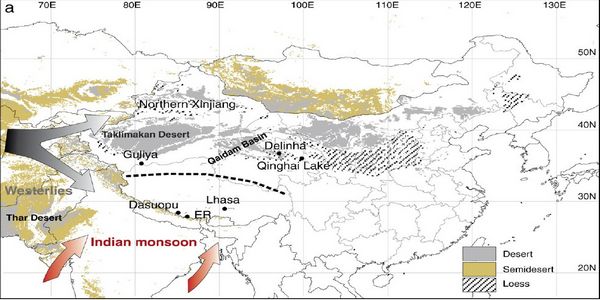
Location map of all data sites mentioned in the text and distribution of dust sources and general patterns for winter and summer circulation systems. The dashed line represents the northern border of the Indian monsoon (34°–35°N in the middle of the plateau).(image by Quaternary Research)
The research of a 108.83-m ice-core record of atmospheric dust deposition at Mt. Qomolangma(Everest), Central Himalaya was completed recently by the researchers of State Key Laboratory of Cryospheric Sciences (SKLCS),Cold and Arid Regions Environmental and Engineering Research Institute. This research has important significance to deduce past changes in atmospheric circulation and climatic regime in the dust source regions.
The central Himalaya can be regarded as an ideal site for developing a long-term ice core dust record to reflect the environmental signals from regional to semi-hemispheric scales. The researchers present a dust record from segments of a 108.83-m ice core recovered from the East Rongbuk (ER) Glacier (27°59′N, 86°55′E;6518 m a.s.l.) on the northeast slope of Mt. Qomolangma (Everest) in the central Himalaya, covering the period AD 600–1960. Results show a significant positive relationship between the dust concentration and reconstructed air temperatures during this period, suggesting a likely cold–humid and warm–dry climatic pattern in the dust source regions, namely Central Asia. This is associated with the variability in the strength of the westerlies and its corresponding precipitation.
The researchers also suggest that further studies are needed to document and fully understand the spatial and temporal patterns of precipitation and temperature changes in Central Asia. Additional sites should be used to further test our out-of-phase hypothesis of dust and precipitation changes. In addition, climate simulations would be useful in testing the relative importance of competing forcing factors under different boundary conditions in and around Central Asia.
The research was funded by the Chinese Academy of Sciences (Grant No. KZCX3-SW-344 and 100 Talents Project) and the Natural Science Foundation of China (Grant No 40825017).

